

MICHIGAN COUNTRY LINES
WATERFURNACE UNITS QUALIFY

Not hearing is believing.
Many homeowners have come to accept that a noisy A/C is a fact of life. But with WaterFurnace, you don’t have to settle.
Nothing can disrupt a perfect summer afternoon in your backyard more than a loud air conditioner. Geothermal users are never disturbed from outside HVAC noise because there’s no outdoor equipment to make any. All the complicated work takes place underground—out of earshot. With WaterFurnace, your peace and quiet is assured. To learn more, contact your local WaterFurnace dealer today.
Geothermal is the only renewable that provides reliable operation 24 hours a day, 7 days a week, 365 days a year.
YOUR LOCAL WATERFURNACE DEALERS
Allendale Allendale Htg & Clg (800) 327-1937 allendaleheating.com
Berrien Springs WaterFurnace Michiana (269) 473-5667 gogreenmichgeo thermal.com
Big Rapids
Stratz Htg & Clg, Inc. (231) 796-3717 stratzgeocomfort.com
Filion/Bad Axe
Air-O-Dynamic Htg & Clg (989) 582-0137 aod-hvac.com
Grand Rapids Bel Aire Htg & Clg
1-888-235-2473 belaire.com
Hart Adams Htg & Clg (231) 873-2665 adamsgeothermal-mi.comam-
Holland
G.H.P. Systems Inc. (616)396-5833 ghpsystems-inc.com
Indian River
M&M Plmb & Htg (231)238-7201 mm-plumbing.com
Lansing Candor Mechanical (517) 920-0890 candormechanical.com
Michigan Center
Comfort 1/Air Serv of Southern Michigan (517)764-1500 airserv.com/southernmichigan/
Mt Pleasant Walton Htg & Clg (989)772-4822 waltonheating.com

Portage Bel Aire Htg & Clg 1-888-235-2473 belaire.com
Portland ESI Htg & Clg (517)647-6906 esiheating.com
Sunfield Mark Woodman Plmb & Htg (517)886-1138 mwphonline.com
Three Rivers
Bel Aire Htg & Clg 1-888-235-2473 belaire.com
Traverse City
Geofurnace Htg & Clg (231)943-1000 geofurnace.com

CO-OP REBATE INCENTIVES
Alger Delta Electric: up to $2,000
Cherryland Electric: up to $2,500
Cloverland: up to $6,275
Great Lakes Energy: up to $5,000
Homeworks/Tri-County Electric: up to $4,750
Presque Isle Electric & Gas Co-op: up to $4,750
Thumb Electric: up to $2,000


EXECUTIVE EDITOR: Casey Clark
EDITOR: Christine Dorr
GRAPHIC DESIGNER: Karreen Bird
RECIPE EDITOR: Christin Russman
COPY EDITOR: Yvette Pecha
CONTRIBUTING EDITOR: Emily Haines Lloyd
PUBLISHER: Michigan Electric Cooperative Association
Michigan Country Lines, USPS591-710, is published monthly, except August and December, with periodicals postage paid at Lansing, Mich., and additional offices. It is the official publication of the Michigan Electric Cooperative Association, 201 Townsend St., Suite 900, Lansing, MI 48933.
Subscriptions are authorized for members of Alger Delta, Cherryland, Great Lakes, HomeWorks Tri-County, Midwest Energy & Communications, Ontonagon, Presque Isle, and Thumb electric cooperatives by their boards of directors.
POSTMASTER:
Send all UAA to CFS.
ASSOCIATION OFFICERS:
Chris O’Neill, HomeWorks TriCounty Cooperative, chairman; Gabe Schneider, Cherryland Electric Cooperative, vice chairman; Shaun Lamp, Great Lakes Energy Cooperative, secretary-treasurer; John Kran, president and CEO.
CONTACT US/LETTERS TO EDITOR: Michigan Country Lines 201 Townsend St., Suite 900 Lansing, MI 48933 248-534-7358 editor@countrylines.com
CHANGE OF ADDRESS: Please notify your electric cooperative. See page 4 for contact information.
The appearance of advertising does not constitute an endorsement of the products or services advertised.
MICHIGAN’S ELECTRIC COOPERATIVES MICHIGAN COUNTRY LINES
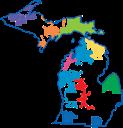
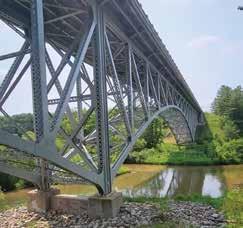


MI CO-OP Community
RECIPE CONTEST
See details on page 10. Favorite Fall Recipes, due Aug. 1; Best Holiday Mains, due Sept. 1 Win a $100 bill credit!
GUEST COLUMN
See details on page 18. Share your fondest memories and stories. Win $200 for stories published!
MYSTERY PHOTO
See details on page 18. Win a $100 bill credit!
To enter contests, submit reader content & more, visit countrylines.com/community
6 SPANNING THE MITTEN: MICHIGAN’S MOST ICONIC BRIDGES
Tracing our state's past through the bridges that built its future.
10 MI CO-OP KITCHEN
Sandwiches & Wraps: effortless to make, impossible to resist.
14 ROOTED IN FLAVOR
Michigan’s farm-to-table experience: where the land inspires the menu.
18 GUEST COLUMN
The Generational Dresses: A PIE&G member recounts how heirloom dresses stitched generations together.

500 J.K. Paul Street
Ontonagon, MI 49953
906-884-4151
800-562-7128
After hours: 866-639-6098
OFFICERS & DIRECTORS
William Hodges, President Lake Linden District 906-934-3743 • district7@ontorea.com
Calvin Koski, Vice President Aura District 906-524-6988 • district4@ontorea.com
Mildred Ann Gasperich, Secretary Boston District 906-337-5079 • district6@ontorea.com
Randy Myhren, Treasurer Green/Firesteel/Toivola District 906-884-4092 • district1@ontorea.com
Jack Lehto, Director Pelkie/Herman/Aura District 906-353-6684 • district3@ontorea.com
Paul Koski, Director Ewen/Trout Creek/Lake Mine District district2@ontorea.com
Michael Gaunt, Director Chassell/Keweenaw Bay District 906-370-8133 • district5@ontorea.com
PERSONNEL
Dallas Aho, CEO/General Manager
Alex Watson, Billing Clerk
Justin Sironen, Operations Manager Kelsey Preiss, Administrative Assistant
OTHER INFORMATION
Date of Incorporation: Sept. 30, 1937 Fiscal year-end: Dec. 31 countrylines.com/coops/ontonagon
Ontonagon County REA is an equal opportunity provider and employer.
Energy Policy Updates: What Members Need to Know
By Dallas Aho, General Manager

MEAP, EWR, Renewable, and Clean Energy Changes
The Michigan Energy Assistance Program (MEAP) took effect through Public Act 95 of 2013. The purpose of the MEAP is to establish and administer programs statewide that provide energy assistance to eligible low-income households. This assistance must include services that enable participants to become or move towards becoming self-sufficient. The original law capped the monthly surcharge at $1.00/month and, over the years, it has ranged from $0.87–$0.99.
When this program became law, utilities were given a choice to participate or not. Energy users were eligible for assistance whether their electric provider participated or not. The biggest difference between participating or not was that those utilities that did not participate were not allowed to shut people off Nov. 1–April 15. The Ontonagon County REA has always voted not to participate in the program in the past.
Public Acts 168 and 169 of 2024 amended Section 9t of Act 95. These recent acts changed some things—they raised the cap on the monthly charge to $1.25 for 2025, with $0.25 annual increases until it hits $2.00/month in 2028. The cap for 2029 will be adjusted in the future. The second change was that all electric utilities must participate in the program, which will create a larger pool of available funds. The third change requires that the money collected in a geographic area be returned, to the extent possible, to that geographic area. The fourth change updates eligibility requirements from 150% of the federal poverty level to 60% of the state median income.
The cap for 2025 is $1.25/month and, on April 24, 2025, the Michigan Public Service Commission ordered that the charge to be collected is $1.25/month. This new charge will first appear on the September 2025 billing.
Energy efficiency programs have been a part of Michigan energy policy since Public Act 295 of 2008. These programs can also be known as Energy Optimization (EO) or Energy Waste Reduction (EWR) programs. Acts 341 and 342 of 2016 modified some of the requirements and included a provision that would allow cooperatives to opt out of such a program at the end of 2021. When these changes became effective, Ontonagon decided to discontinue their EO program at the end of 2021. These programs suffered from high administrative costs and low participation.
In May of 2022, we voluntarily joined a new EO program (Michigan Clean Energy Program) administered by WPPI. Ontonagon decided to discontinue their EO program with WPPI in April of 2024. Ontonagon has been self-administering their own EO program since.
Public Act 229 of 2023 altered Michigan Energy policy again. The major change to the EO program is cooperatives are again mandated to offer an EO program. The state of Michigan estimates that costs should be less than 3.5% of the previous year’s sales. Ontonagon has partnered with other coops in Michigan to reduce those costs. These costs are not finalized at this time. We will update the membership once they are known, and these costs will take effect on the January 2026 billings.
Pay Attention to Safety When Using Spring Lawn Mowers & Other Outdoor Power Equipment
Know Your Machine, Review Safety Procedures, and Follow the Manufacturer’s Guidance
Spring is here, and as we get our lawn mowers and other outdoor power equipment out from storage to work in our yards, businesses, and other green spaces, it’s important to keep safety in mind.
Here are safety tips for readying and using your outdoor power equipment:*
• Know not all lawn mowers are the same. Whether your mower is a garden tractor, zero-turn mower, or other, it has a unique design, requirements, weight classification, and other differences that impact how to use it safely. The newest machines have the latest safety standards.
• Know your specific machine. Many mowers may look similar, but the technology is ever-evolving with advanced safety systems. They vary in design, power supply, performance, operating parameters, and more. Your manufacturer-supplied owner’s manual will guide you in these differences. Read your owner’s manual.
• When using mowers on slopes, follow the manufacturer’s guidance to the letter.
• Do not disable or alter manufacturer-installed safety equipment.
• Walk your yard before mowing. Slopes, wet grass, and weather may impact equipment performance, as well as safe handling procedures. Pick up sticks and limbs that may have fallen to the ground over the winter and any loose objects that a mower could hit. Inspect trees for damaged limbs that may get in your way when mowing.
Public Act 235 of 2023 mandates renewable as well as clean energy standards. Electric providers will need to ensure that 50% of all electric energy sold by 2030 is from renewable sources. This number jumps to 60% by 2035. This act also requires that 80% of energy used will be generated from clean sources, with a 100% requirement by 2040. Wolverine Power Supply Cooperative, Inc. is our wholesale provider, and they have assured Ontonagon that they will be able to meet these Michigan-mandated requirements.

• Look over equipment before use. Check the air filter, oil level, and gasoline tank. Watch for loose belts and missing or damaged parts. Replace any parts needed or take your equipment to a qualified service representative.
• Protect your power. Use only E10 or less fuel in gasolinepowered outdoor power equipment if it is not designed for higher ethanol blends. Add a fuel stabilizer if you don’t use up all the fuel in the tank right away. Burn off any fuel before storing the mower for more than 30 days. For battery-powered equipment, only use battery packs specified by the manufacturer. Follow all charging instructions as outlined in the owner’s manual. Be sure to store fuel and batteries safely. Keep batteries away from other metal objects, store them in a climate-controlled area, and never stack batteries.
• Keep children and pets away from machines during operation.
• Keep your mower clean. It will run more efficiently and last longer. Always remove dirt, oil, or grass before using and storing. Store equipment in a dry place, avoiding damp or wet environments.
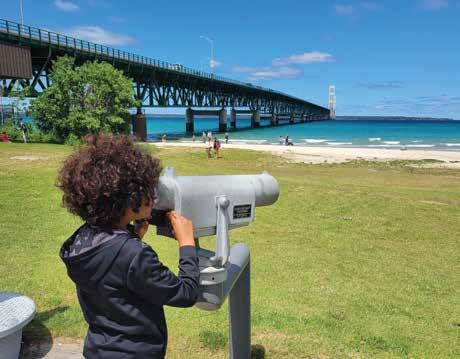
Spanning the Mitten Michigan’s Most Iconic Bridges
Michigan’s unique geography—with over 11,000 inland lakes, 120 major rivers, and borders on four Great Lakes—has made bridges essential to connecting people, peninsulas, and even countries. The state boasts more than 11,000 bridges, each with a distinct story and role in Michigan’s landscape.
International Bridges
Three major bridges connect Michigan to Canada. The Ambassador Bridge , opened in 1929, links Detroit and Windsor and remains the busiest international land border crossing in North America.
The Blue Water Bridge , built in 1938 and twinned in 1997, connects Port Huron to Sarnia, Ontario.
In the Upper Peninsula, the Sault Ste. Marie International Bridge spans the St. Mary’s River, linking the twin cities of Sault Ste. Marie in Michigan and Ontario. The bridge overlooks the Soo Locks, a critical shipping passage between Lake Superior and the lower Great Lakes.
Iconic Michigan Spans
The most famous bridge in Michigan is the Mackinac Bridge , also known as “Mighty Mac” or “Big Mac.” Opened in 1957, it spans fi ve miles across the Straits of Mackinac, linking Michigan’s upper and lower peninsulas. It remains one of the longest suspension bridges in the Western Hemisphere.
Opened in 1959, the Portage Lake Lift Bridge connects Houghton and Hancock in the Upper Peninsula. It’s the world’s heaviest and widest double-deck vertical lift bridge. In winter, its lower deck is lowered for snowmobiles while vehicles continue on the upper level.
Miniature and Replica Bridges
Several pedestrian bridges celebrate the Mighty Mac. In St. Louis, the 120-foot Mini Mac Bridge spans a pond shaped like the Lower Peninsula.
In Reed City’s Rambadt Park, the Little Mac Bridge is a 150-foot-long wooden suspension bridge crossing the Hersey River.
Near Mesick, the Little Mac Footbridge —at 246 feet—is the longest wooden suspension bridge in the Lower Peninsula and links the Manistee River Trail with the North Country Trail.
Parks with Notable Bridges
Historic Bridge Park in Battle Creek features restored 19th- and early 20th-century truss bridges, picnic areas, trails, and educational displays.
McCourtie Park in Cement City has 17 whimsical concrete bridges designed in faux bois style, mimicking wood textures. The park sits on the former estate of cement magnate W.H.L. McCourtie.
In Croswell, the Swinging Bridge built in 1905—is a 139-foot pedestrian bridge made of wire cables and wooden planks. It was originally constructed by the Michigan Sugar Company for worker access.
Deerfi eld Nature Park in Isabella County includes four bridges: two swinging suspension bridges, the Lewis Pontiac Bridge, and the Fisher Annex Covered Bridge, which was rebuilt after a 1995 fi re.
Covered Bridges
Michigan is home to several historical covered bridges. White’s Covered Bridge , built in 1867 over the Flat River near Smyrna, was rebuilt after a 2013 fi re.
The Ada Covered Bridge , also erected in 1867, spans the Thornapple River and was restored in 1979.
Mackinac Bridge
North of Lowell, the Fallasburg Covered Bridge (1871) is part of a preserved historic village and is still open to vehicle traffi c.
The Langley Covered Bridge , built in 1887 near Centreville, is the longest covered bridge in Michigan at 282 feet and remains open to vehicles.
In the 1960s, Pierce Stocking designed a scenic bridge that’s now part of the Sleeping Bear Dunes National Lakeshore. It was reconstructed in 1986.
In Frankenmuth, the Holz Brucke Covered Bridge (1979) crosses the Cass River and is open to both vehicles and pedestrians, complementing the town’s Bavarian charm.
Unique and Scenic Crossings
In Midland, The Tridge is a threeway wooden footbridge built in 1981 where the Chippewa and Tittabawassee Rivers meet, linking three parks and paths.
At Boyne Mountain, the SkyBridge is the world’s longest timbertowered suspension bridge at 1,200 feet. It includes a glass fl oor section suspended 118 feet above a forested valley.
The Cut River Bridge , a cantilevered deck truss bridge along US-2 in the Upper Peninsula, towers 147 feet above the gorge. Trails and 230 stairs below lead to the Lake Michigan shoreline.
The Cooley Bridge in Manistee County spans the Pine River at 613 feet and 95 feet high. Built in 1934, it was recognized for its beauty and includes picnic areas and stairways to the river.



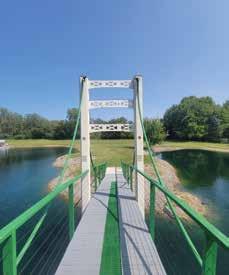
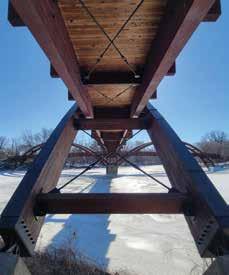
Whether they’re soaring above rivers, swaying beneath your feet, or tucked into scenic parks, Michigan’s bridges are more than just pathways—they’re part of our state’s charm, history, and adventure. So, next time you’re roadtripping or hiking, keep an eye out— you never know when you’ll stumble upon one of these architectural gems spanning the mitten.
Scan the QR code to watch a video of our
Cassondra Scott is a content creator, writer, and social media influencer at Cassondra Wanders— sharing small businesses and sights to see all over the state of Michigan.
Bridge Tour.
Sault Ste. Marie International Bridge
Fallasburg Covered Bridge, Lowell
Mini Mac Bridge, St. Louis
The Tridge, Midland
HOW TO PREVENT ELECTRIC SHOCK DROWNING
Each year, 3,800 people in the U.S. die from drowning. Electric shock drowning occurs when an electric current escapes boats, docks, and lights near marinas, shocking nearby swimmers. There are no visible signs of current seeping into water, which makes this a hidden danger. The electric shock paralyzes swimmers, making them unable to swim to safety.
ELECTRICAL SAFETY TIPS FOR:
Swimmers
• Never swim near a boat or launching ramp. Residual current could flow into the water from the boat or the marina’s wiring, potentially putting anyone in the water at risk of electric shock.
• If you feel any tingling sensations while in the water, tell someone and swim back in the direction from which you came. Immediately report it to the dock or marina owner.
Boat Owners
• Ensure your boat is properly maintained and consider having it inspected annually. GFCIs and ELCIs should be tested monthly. Conduct leakage testing to determine if electrical current is escaping the vessel.
• Use portable GFCIs or shore power cords (including “Y” adapters) that are “UL- Marine Listed” when using electricity near water.
• Regularly have your boat’s electrical system inspected by a certified marine electrician. Ensure it meets your local and state NEC, NFPA, and ABYC safety codes.
MICHIGAN’S WATERFALLS








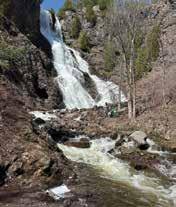
1. The beautiful and remote West Branch Huron Falls on an autumn afternoon! Nathan Miller
2. Hiding behind O Kun De Kun falls. Johanna Simula
3. A winter walk to Hungarian Falls. Mary Kaminski
4. Agate Falls. Connie Pentti
5. Beautiful Montreal Falls. Max Jouppe
6. Where water dances with stone, nature’s melody cascades in timeless grace. Bond Falls, MI. Holly Pelto
7. Happy kids exploring waterfalls. Emily Johnson
8. Barkell elementary 5th grade field trip to Tahquamenon Falls! Angie Wantaja
9. Douglas Houghton Falls, spring 2025, Houghton County, MI. Jean Fettig
Submit A Photo & Win A Bill Credit! Ontonagon REA members whose photos we print in Michigan Country Lines during 2025 will be entered in a drawing. Four lucky members will win a credit of $50 on their December 2025 energy bills! Upcoming Topics and Deadlines: College Towns, due July 25 (Sept./Oct. issue)
Pet Personalities, due Sept. 25 (Nov./Dec. issue)
To submit photos, and for details and instructions, go to http://bit.ly/countrylines. We look forward to seeing your best photos!
SANDWICHES & WRAPS
Effortless to make, impossible to resist—perfect bites for any time of day.

WINNING RECIPE!
SUMMER HERB CHICKEN SALAD WRAPS
Rachel Smith, Midwest Energy
1 pound skin-on/bone-in chicken breasts or thighs
2 teaspoons salt (to season chicken)
2 teaspoons freshly ground black pepper (to season chicken)
1 tablespoon olive oil
½ cup mayonnaise
1 tablespoon Dijon mustard
2 green onions, thinly sliced 1–2 celery stalks, fi nely chopped
1 tablespoon fresh dill, minced
1 tablespoon fresh basil, minced
½ teaspoon fresh tarragon, minced (optional)
4 large tortillas
• romaine lettuce, roughly chopped
Preheat oven to 350 F. Prepare a baking sheet covered in parchment paper. Add the chicken to the baking sheet and season well with salt and pepper; make sure to get under the skin and on all sides. Drizzle with olive oil. Roast in the oven (35–40 minutes for chicken breasts, or 45–55 minutes for chicken thighs), until internal temperature reaches 155 F. Remove from oven, transfer to plate, and allow to cool for 15 minutes. (Note: By removing at 155 F, the temperature will continue to rise with carry-over cooking.) Once cool enough to handle, remove the meat from skin and bones. Cut up into pieces about ½–¾ inches thick. In a bowl, combine the mayonnaise, Dijon mustard, green onions, celery, dill, basil, and tarragon. Add the chicken pieces. Slowly stir ingredients together. Add additional salt and pepper to taste. Place in the fridge for 2 hours before serving. Or, if serving right away, place the bowl in the freezer for 15 minutes to allow it to chill. Spoon chicken salad mixture onto tortillas and top with romaine. Roll up. Makes about 2 cups chicken salad. You can easily double recipe.
Watch a video of this month’s winning recipe at micoopkitchen.com/videos
RECIPE CONTEST Win a $100 energy bill credit!
Favorite Fall Recipes, due Aug. 1; Best Holiday Mains, due Sept. 1. Submit your favorite recipe for a chance to win a $100 bill credit and have your recipe featured in Country Lines with a photo and a video. Submit your recipe at micoopkitchen.com, or send it via email (include your full name and co-op) to recipes@countrylines.com


MINI HAM SANDWICHES
Deanne Quain, Great Lakes Energy
12 King’s Hawaiian Sweet Dinner Rolls
1 pound deli ham, shaved
½ pound Swiss cheese
1 stick butter
1 tablespoon Worcestershire sauce
1 tablespoon poppy seeds
2 tablespoons brown sugar
1 tablespoon Jack Daniel Dijon mustard
Preheat oven to 350 F. Cut entire pack of rolls horizontally. In a 9x13-inch baking dish, place bottom halves of rolls evenly. Cover with ham and cheese and place top halves of rolls on top. To a medium saucepan over medium heat, add the butter and melt. Add the Worcestershire sauce, poppy seeds, brown sugar, and mustard, and heat while stirring. Pour liquid over sandwiches and bake covered for 20 minutes, or until the cheese melts. Makes 12 sandwiches.

BAKED MONTE CRISTO SANDWICH
Mary Ellen Wynes, Homeworks Tri-County
2 eggs
2 tablespoons milk
1 teaspoon vanilla extract
4 slices bread
½ pound sliced baked ham
½ ounce Gruyere or Swiss cheese slices
¼ cup strawberry jam
• powdered sugar, for serving
Preheat oven to 450 F. Prepare a baking sheet covered in parchment paper. In a shallow dish (large enough to fi t a sandwich), beat the eggs with the milk and vanilla. Set aside. Assemble two slices of the bread with ham and cheese. Spread the other two slices with strawberry jam. Slightly compress sandwich. Dip both sides of the sandwich in the egg wash for 5 seconds on each side.
Transfer to the baking sheet. Bake 6 minutes, fl ip, and bake 5 more minutes, until browned and the cheese has melted. Sprinkle with powdered sugar before serving.

WARM TURKEY PESTO SANDWICHES
Mary Card, Great Lakes Energy
6 burger or sub buns
6 slices deli turkey meat
6 slices provolone cheese
3 tablespoons prepared basil pesto
3 tablespoons mayonnaise
1 tablespoon melted butter
Preheat oven to 400 F. Line a rimmed baking sheet with foil or parchment paper. Separate the burger or sub buns. Fold the turkey and cheese to fi t the bottom of buns, tearing or cutting to fi t. In a small bowl, combine the basil pesto and mayonnaise; stir until combined. Spread a thin layer over the six bun tops. Place bun tops on and transfer the sandwiches to the baking sheet. Brush tops with melted butter and heat 8–10 minutes or until cheese melts. Serves 6.

SOUTHWEST CHICKEN PANINI
Nancy Popa, Cherryland Electric
2 cups fresh cilantro, leaves and stems, loosely packed
3–4 garlic cloves, minced
1 jalapeño, seeded and fi nely chopped
• juice of ½ lime
⅛ teaspoon salt
2 tablespoons olive oil
¼ cup mayonnaise
1 tablespoon canned chipotle chili in adobo, minced
½ teaspoon sugar
4 slices hearty white or wheat sourdough bread, ½″ per slice
¼ cup butter, softened
2 ounces pepper jack or Havarti cheese, thinly sliced
3 ounces rotisserie chicken, torn into large pieces
In a food processor, blend cilantro, garlic, jalapeño, lime juice, and salt. Slowly add oil to form a pesto paste. In a small bowl, mix mayonnaise, chipotle chili, and sugar. Lightly butter the outside of each bread slice. Spread mayo on two slices and pesto on the other two. Top pesto sides with cheese and chicken, then close with mayo slices. Grill in a panini press or skillet for 3–4 minutes, checking for doneness. Makes 2 paninis.
From Curiosity to Connection: My Electric Co-op Journey
By David Wahl
Eighteen months ago, I had no idea what an electric cooperative was—let alone how one could completely change my life. Now, I’m proud to say I’ve been part of the National Rural Electric Cooperative Association’s (NRECA) Youth Tour and Youth Leadership Council (YLC) and discovered an amazing community along the way.
It All Started in D.C.
In June 2024, I traveled to Washington, D.C., with nearly 2,000 students from across the country. Our local co-ops chose us to attend the NRECA Youth Tour—a once-in-alifetime opportunity. Out of all the Michigan students, I was selected to represent the state’s electric cooperatives on the Youth Leadership Council.
When I gave my campaign speech in Washington, D.C., I truly didn’t understand the magnitude of the role. I saw an opportunity to grow, learn, and connect with others—and I jumped at it. I quickly became part of a team of 45 students from nearly every state. We were all unique, but we shared a desire to serve and make a difference.
Bringing Joy Back Home
One of my favorite parts of being a “YLCster” was planning a community project with my sponsoring co-op, Great Lakes Energy. I brought back an idea from when I was little—a “Stuffed Animal Sleepover” at the library—and turned it into a school event for over 160 elementary students. The kids dropped off their “stuffies” at school, and I spent the night posing them in fun scenes around the building. The next day, we shared the photos in a slideshow so the kids could see the wild adventures their stuffies had overnight. The event was a hit in the school and on social media!
PowerXchange in Atlanta
As part of YLC, I also wrote and presented a speech to the Great Lakes Energy Board of Directors in hopes of becoming the YLC National Spokesperson. Even though I didn’t get to give the speech on stage at NRECA’s

PowerXchange conference in Atlanta, I was still able to represent Michigan’s co-ops and introduce myself to nearly 6,000 conference attendees.
The whole week in Atlanta was unforgettable. I worked alongside NRECA staff, helped attendees, and made memories I’ll never forget—from visiting the country’s largest aquarium and touring Mercedes-Benz Stadium to catching a Scotty McCreery concert with a front-row view. We came in as strangers, but we left as family.
Looking Ahead
I’m so grateful to the electric co-ops for everything they’ve given me over the past year. This experience has changed my life. To the students heading to Washington, D.C., this June—I’m excited for you. You’re about to take the first steps on an incredible journey. I know you’ll come back with more than just memories—you’ll come back inspired to lead and ready to serve.
David Wahl is a junior at St. Mary Cathedral School in Gaylord, Michigan.
He represented Great Lakes Energy Cooperative on the NRECA’s Youth Tour and Michigan’s electric cooperatives on the NRECA Youth Leadership Council.
He also serves as a student representative to the City of Gaylord’s Downtown Development Authority.


From Capitol Hill to Co-op Storm Recovery: John Kran’s
First Weeks at MECA
Drawing on a career in advocacy and policy, Kran brings calm, clarity, and commitment to Michigan’s electric co-ops in a time of crisis.
By Emily Haines Lloyd
When John Kran stepped into his new role as president and CEO of the Michigan Electric Cooperative Association (MECA), he expected the usual whirlwind that comes with leading a statewide organization. What he didn’t expect was an unprecedented ice storm to tear through northern Michigan just weeks into his tenure—impacting thousands of cooperative members and sending crews scrambling to restore power across some of the state’s most remote areas.
But pressure is nothing new to Kran. Before joining MECA, he spent years advocating for Michigan farmers as National Legislative Counsel for Michigan Farm Bureau, championing rural communities at the state and federal levels. Earlier in his career, he advised Rep. Bill Huizinga in Michigan’s 2nd District, where he learned to navigate policy challenges and political gridlock.
So, when the ice storms hit, Kran did what he does best—got into the mix, assessed both the big picture and the smallest details, and rolled up his sleeves.
We recently sat down with Kran to discuss his whirlwind start at MECA, what prepared him for the job, and what lies ahead for Michigan’s electric cooperatives.
Q: It’s fair to say your beginning at MECA was sort of “trial by ice,” if you’ll forgive the pun.
A: Yeah, I was only a few weeks in when those storms hit, and it was all hands on deck. It gave me an immediate look at the grit and collaboration that define our co-ops.
Were there key moments that prepared you for this leadership role at MECA?
Working in D.C. for a member of Congress gave me a real appreciation for how things get done—or don’t—in government. It taught me patience, persistence, and how to translate local concerns into national conversations. My time with Michigan Farm Bureau was another big one. I had the chance to advocate for farmers on issues that directly affected their livelihoods. That gave me a deeper understanding of rural infrastructure needs, including energy. It’s all come full circle.
You spent years advocating on behalf of Michigan farmers. How do you plan to carry that experience into the energy sector?
The playbook is similar—listen to your people, know the issues, and build strong relationships with policymakers. I plan to be in those rooms in Lansing and D.C., making sure rural energy needs are understood and prioritized.
How important is it to bring member voices directly to policymakers?
It’s critical. I can talk all day about the impact of a policy, but when a lineworker, a general manager, or a member shares their story—that’s what sticks. If we don’t tell our story as a cooperative family, someone else will—and probably not the way we’d tell it ourselves.
What excites you most about this opportunity?
Every co-op has a story, and I get to help amplify those stories, find shared challenges, and advocate for solutions. It’s an exciting time in energy— technology, policy, and consumer expectations are evolving quickly, and co-ops are uniquely positioned to lead.
Outside of work, how do you unwind with your family?
We enjoy Michigan’s seasons—time at the lake in summer and skiing in winter. We’re also trying to visit as many national parks as we can.

Rooted in Flavor
Michigan’s Farm-to-Table Experience
Where the Land Inspires the Menu
By Emily Haines Lloyd
The farm-to-table movement runs deep in Michigan, where a rich agricultural landscape meets a strong spirit of collaboration between farms and restaurants. Across the state, many establishments don’t just partner with local growers—they are the growers, operating their own farms to ensure every ingredient is fresh, seasonal, and full of Michigan flavor.
You don’t have to look far to fi nd great examples—some are right within our electric cooperative communities.

Farm Club farmclubtc.com

Farm Club: Growing Connection in Traverse City
A member of Cherryland Electric Cooperative, Farm Club near Traverse City is more than just a restaurant—it’s a farm, a bakery, a brewery, and a community gathering place. Here, chefs build their menus around what’s ripe in their fi elds, shaping meals that refl ect the rhythm of the seasons. Heirloom beans simmer into rich soups, and just-picked corn becomes a fragrant pozole. Everything is guided by the land’s natural cadence.
A Taste of Place
This hyper-local approach embraces the concept of terroir—the idea that flavor is shaped by the environment. Soil, water, and climate combine to give ingredients a distinct character, and in Michigan, that character is unmistakable. From juicy summer berries to earthy autumn squash, our state’s seasonal bounty inspires menus that evolve with the harvest.
In Suttons Bay, another Cherryland Electric member, 9 Bean Rows, exemplifi es this connection to place. Part farm, part bakery, and part café, the business grows its own produce, bakes artisanal

bread on-site, and runs community programs that promote healthy eating. Their signature sourdough and sea salt fennel loaves embody the taste of Michigan—right down to the well water used in the baking process.
Pond Hill Farm: A Full-Sensory Experience
On 238 scenic acres near Harbor Springs, Pond Hill Farm—a Great Lakes Energy member—offers an immersive farm-to-table experience. Visitors can tour the fi elds, sample beer and wine crafted from the farm’s own hops and grapes, and savor wood-fi red pizza made with fresh, homegrown ingredients. Even in winter, Pond Hill keeps the connection strong with intimate supper clubs featuring root vegetables and greens harvested from heated hoophouses.
But Pond Hill’s mission goes beyond food. From barnyard animals to seasonal festivals, the farm invites guests of all ages to engage with agriculture fi rsthand and experience the work— and wonder—behind every meal.
Food That Builds Community
In Michigan, farm-to-table isn’t just about eating well—it’s about creating stronger, more connected communities. By sourcing ingredients locally, restaurants support nearby farmers, strengthen regional economies, and create welcoming spaces where people come together.
At 9 Bean Rows, the impact extends into schools. Their food program supplies fresh produce to students in Leelanau County and Traverse City, introducing young people to nutritious, local food and helping them understand where it comes from.
Similarly, Farm Club and Pond Hill Farm host events like farm tours, pizza nights, and seasonal dinners, transforming food into a shared experience that brings neighbors, families, and visitors together.
More Than a Meal
In Michigan, farm-to-table is more than a dining trend—it’s a celebration of land, people, and place. It’s about honoring farmers, cultivating community, and creating food that’s rooted in care and connection.
Every dish tells a story—of the soil that nourished it, the hands that harvested it, and the community that gathers around it.
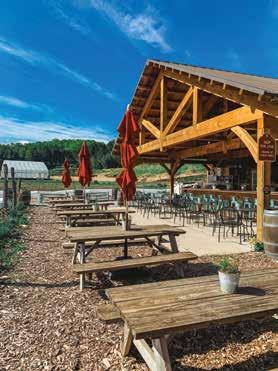

“ IN MICHIGAN, FARM-TO-TABLE ISN’T JUST ABOUT EATING WELL—IT’S ABOUT CREATING STRONGER, MORE CONNECTED COMMUNITIES.”
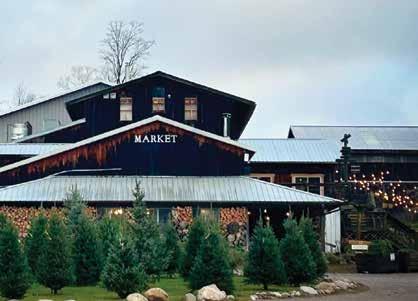

SENATOR DEBBIE STABENOW

Championing Rural Michigan and Electric Cooperatives
By Emily Haines Lloyd
U.S. Sen. Debbie Stabenow may be the National Rural Electric Cooperative Association’s recently minted Lifetime Achievement Award recipient, but Michigan’s senior senator didn’t start her career amidst accolades in glitzy ballrooms.
A FOUNDATION OF SERVICE
Raised in Clare, Michigan, where “neighbors helping neighbors” was not only a sentiment but a way of life, Stabenow has spent decades ensuring that Michigan’s rural regions, farmers, and electric cooperatives thrive.
Stabenow’s rural upbringing profoundly shaped her approach to public service. She recalls the close-knit nature of her hometown, where her parents—a nurse and a small business owner—instilled the values of hard work, community, and giving back.
“My family wasn’t political,” said Stabenow. “But they instilled in their children that if you benefit from something, you owe it to pay it back. It’s your responsibility to help where you can.”
ROLLING UP HER SLEEVES
“Public service is at its best when it’s driven by people from every background.”
She found an opportunity to help as a 24-year-old graduate student at Michigan State University working to stop the closure of a nursing home—the last in Ingham County serving lowincome seniors.
The facility was saved, but Stabenow’s fight was just beginning. One of the key leaders trying to close the facility was the county commissioner in her own district. The next election, Stabenow ran against that commissioner—and won his seat. Two years later, she was the chair of the board—the first woman and youngest to hold that position in Ingham County.
From there, her journey led to the Michigan House of Representatives, U.S. House, and ultimately the U.S. Senate, fueled by a commitment to the most pressing needs of the communities she served.
ADVANCING RURAL DEVELOPMENT
It’s unsurprising then that Stabenow sought government committees that would most directly impact her constituents. As chair of the Senate Agriculture Committee, Stabenow became a fierce advocate and authored multiple farm bills that expanded the scope of agricultural policy.
“What we grow in Michigan reflects what people want,” she said, highlighting the significance of tailoring policies to the diverse needs of farmers and consumers.
Her leadership extended to food security programs, bio-based economies, and clean energy initiatives, all designed to bolster economic viability and quality of life in rural areas. Through her efforts, Michigan’s farmers have gained access to expanded crop insurance, renewable energy resources, and grants supporting sustainable practices.
CHAMPIONING ELECTRIC COOPERATIVES
Electric cooperatives hold a special place in Stabenow’s legacy. She has been a tireless advocate for rural economic development. Cherryland Electric Cooperative CEO Rachel Johnson notes that Cherryland has leveraged a federal USDA program to create a revolving loan fund that has supported almost 40 locally owned small businesses in their service territory with over $7 million of zero-interest loans to expand their businesses and create and retain local jobs.
“The impact of our loan fund will be felt for generations, and we are incredibly proud of the success of our borrowers,” said Johnson. “None of this would be possible without Senator Stabenow’s support for rural Michigan.”
Additionally, Stabenow’s work on programs like the Rural Energy
for America Program (REAP) empowered electric cooperatives and rural communities to invest in renewable energy, reducing costs and environmental impact.
Her dedication to decarbonization was also reflected in her support for the New ERA grant program, a groundbreaking initiative that provides low-interest loans and grant funding for electric cooperatives transitioning to renewable energy sources.
“Jobs, energy access, and sustainability are interconnected,” she noted. “These programs help create prosperity in rural Michigan.”
A LEGACY OF CONNECTION AND HUMILITY
Known for her approachability and collaborative spirit, Stabenow has worked alongside policymakers from both parties to achieve tangible results. Her relationships with
rural constituents and cooperative members have remained authentic and grounded.
“She’s never forgotten where she came from,” said former MECA President Craig Borr. “Senator Stabenow stands for so much of what electric cooperatives stand for—collaboration, creative solutions, and community. She’s been a true champion of rural Michigan, and we will always be grateful for her policy work in the U.S. Senate.”
Now retired from the Senate, Stabenow looks forward to continuing her advocacy work from her home state. She also offers advice to Michiganders aspiring to public service:
“Don’t wait for someone else. If you see something that needs to be done, step up,” said Stabenow. “Public service is at its best when it’s driven by people from every background.”

“Don’t wait for someone else. If you see something that needs to be done, step up.”
Where In Michigan Is This?
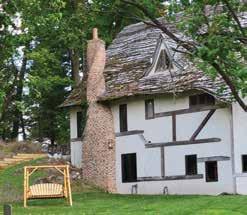


MYSTERY PHOTO
Win a $100 energy bill credit! Identify the correct location of the photo above by July 25 and be entered into a drawing to win a $100 electric bill credit. Enter your guess at countrylines.com/community

May 2025 WINNER!
Our Mystery Photo winner is Debra Anthony, a Thumb Electric Cooperative member who correctly identified the photo as the Statue of Liberty Torch Sculpture in Rogers City, Michigan. Winners are announced in the following issues of Country Lines: January, March, May, July/August, September, and November/December.
The Generational Dresses
By Sharon Libich, a Presque Isle Electric & Gas Co-op member
In 1978, I found my wedding dress in the pages of bridal magazines— a far cry from today’s online searches. I never imagined that decades later, its delicate train would become part of my granddaughter’s First Holy Communion dress.
Family tradition has always been woven into the fabric of our lives. My godmother hand-sewed my Christening gown in 1959. That same dress was worn by my daughters in 1981 and 1987, and again by my granddaughter Hailey when she was born in 2015.
Our Communion dress holds a similar legacy. I wore it in 1967, my daughters in 1988 and 1994, and Hailey in 2022. Wanting a full-length dress, she asked for something special—and I knew just what to do. I carefully repurposed the 5-foot train from my wedding gown.

Reassembling the dress was truly a labor of love, but seeing Hailey in it made every stitch worth it. The tradition continues—and the dress lives on.
GUEST COLUMN Win $200 for stories published! Share your fondest memories and stories. Win $200 for stories published. Visit countrylines.com/community to submit.








